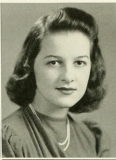(4 August 1921 – 23 November 1990 )
Helen Shedd Sherwin was born in Raleigh, North Carolina to Edith Sherwin nee Dodson and Melvin Ernest Sherwin. Her father was a professor of agriculture at North Carolina State College in that city. She earned her Bachelor’s degree from Women’s College of the University of North Carolina (which later became the University of North Carolina at Greensboro) in 1941. The photo of Ms. Sherwin (above) is from the 1941 yearbook of the Women’s College of the University of North Carolina.
Ms. Sherwin studied mycology under Dr. John Nathaniel Couch at the University of North Carolina at Chapel Hill. She deposited ca. 60 vascular plant specimens to NCU. They were collected in the spring of 1943, probably as part of her botanical studies, as they were all collected around Chapel Hill, especially in Battle Park, a favorite site for teaching field botany. Ms. Sherwin deposited about 60 fungal specimens in NCU; most were collected during the summers of 1942 and 1943 in the vicinity of the Highlands Biological Station in Macon County, North Carolina. Ms. Sherwin earned a Masters Degree in Botany in 1944; the title of her thesis was “Some wild yeasts found around Chapel Hill.”
Ms. Sherwin married Dr. John Chung Kang Yu in 1953; she retained her maiden name professionally.
Ms. Sherwin worked for the United States Department of Agriculture in the plant pathology section for eleven years.1 She deposited specimens in BPI between 1946 and 1953; many were fungi found on Sorghum, Glycine, Cynodon, Trifolium, Paspalum, and Lotus, and many were collected with USDA colleagues K. W. Kreitlow and C. L. Lefebvre.
Helen Sherwin described Helminthosporium sorghicola Lefebvre & Sherwin, a a pathogen of Sorghum in the southern United States. Specimens collected by Helen Sherwin, including those deposited in NCU and BPI, can be searched at mycoportal.org
According to her obituary in The Washington Post:
“Helen Sherwin Yu, 69, a founder and past president of the Plain Dirt Garden Club in Potomac and a former Agriculture Department plant pathologist, died of cancer Nov. 23 [2000] at her home in Potomac…She moved to the Washington are in 1944 and worked for 11 years as a plant pathologist at the Agriculture Department’s research facility in Beltsville [Maryland]. She was a member of Potomac United Methodist Church. Her husband, Dr. John C.K. Yu, died in 1979. Survivors include two daughters, Janet Yahiro of Columbia and Betsy King of Rockville; four sisters, Evelyn Beaven of Solomons, Md., Ernestine Spillman of Atlanta, Dorothy Brown of Agawam, Mass., and Hilda Sherwin of Bloomington, Ind.; a brother, Sidney Sherwin of Salisbury, N.C.; and four grandchildren.”1
PUBLICATIONS (possibly incomplete list):
Lefebvre, C. L. and H. S. Sherwin. 1945. Observations on the Bacterial Canker of Cowpea. Phytopathology 35(6): 487.
Lefebvre, C. L. and H. S. Sherwin. 1945. Races of Helminthosporium turcicum. Phytopathology 35(6): 487.
Olive, L. S., C. L. Lefebvre, and H. S. Sherwin. 1946. The fungus that causes Sooty Strip of Sorghum spp. Phytopathology 36(3): 190-200.
Sherwin, H. S., C. L. Lefebvre, and R. W. Leukel. 1946. Effect of seed treatment on Soybeans germinated at 4 temperatures. Phytopthology 36(8): 688.
Sherwin, Helen Shedd. 1948. Studies on some wild yeasts from Chapel Hill and vicinity. Journal of the Elisha Mitchell Scientific Society 64(2): 267-276.
Lefebvre, C. L. and Helen S. Sherwin. 1948. An undescribed species of Helminthosporium on Sudan Grass and Sorghum. Mycologia 40(6): 708-716.
Sherwin, H. S., C. L. Lefebvre and R. W. Leukel. 1948. Effect of seed treatment on the germination of Soybeans. Phytopathology 38(3): 197-204.
Lefebvre, C. L., A. G. Johnson and Helen S. Sherwin. 1949. An undescribed species of Periconia. Mycologica 41(4): 416-419.
Lewis, A. J., H. S. Sherwin, I. Forbes, and R. E. Wagner. 1949. Rhizoctonia solani, a destructive pathogen of Alta-Fescue, Smooth Brome Grass, and Birdsfoot Trefoil. Phytopathology 39(1): 1.
Lefebvre, C. L. and H. S. Sherwin. 1950. Inheritance of resistance to Bacterial Canker in Cowpea, Vigna sinensis. Phytopathology 40(1): 17-18.
Kreitlow, K. W., Helen Sherwin and C. L. Lefebvre. 1950. Susceptibility of Tall and Meadow Fescues to Helminthosporium infection. Plant Disease Reporter 35(6): 189-190.
Sherwin, H. S. and C. L. Lefebvre. 1951. Reaction of Cowpea varieties to Bacterial Canker. Plant Disease Reporter 35(7): 303-317.
Sherwin, H. S. 1951. The relationship of Cercospora sp. to seed discoloration in Soybeans. Phytopathology 41(6): 565.
Sherwin, Helen S. 1952. Target Spot on soybeans in Virginia. Plant Disease Reporter 36(12): 491.
Sherwin, H. S. and K. W. Kreitlow. 1952. Discoloration of soybean seeds by the frogeye fungus, Cercospora sojina. Phytopathology 42(10): 568-572.
Jehle, R. A., A. E. Jenkins, K. W. Kreitlow and H. S. Sherman. 1952. An outbreak of Phyllosticta canker and Leafspot on Soybeans in Maryland. Phytopathology 42(6): 342.
SOURCES:
1. “Helen S. Yu, Garden Club President” Obituary, The Washington Post, 24 November 1990. Accessed on 23 June 2016. https://www.washingtonpost.com/archive/local/1990/11/24/author-roald-dahl-dies/0a2b6f8b-c4f0-4b42-8fd1-8493bcbd94f1/
